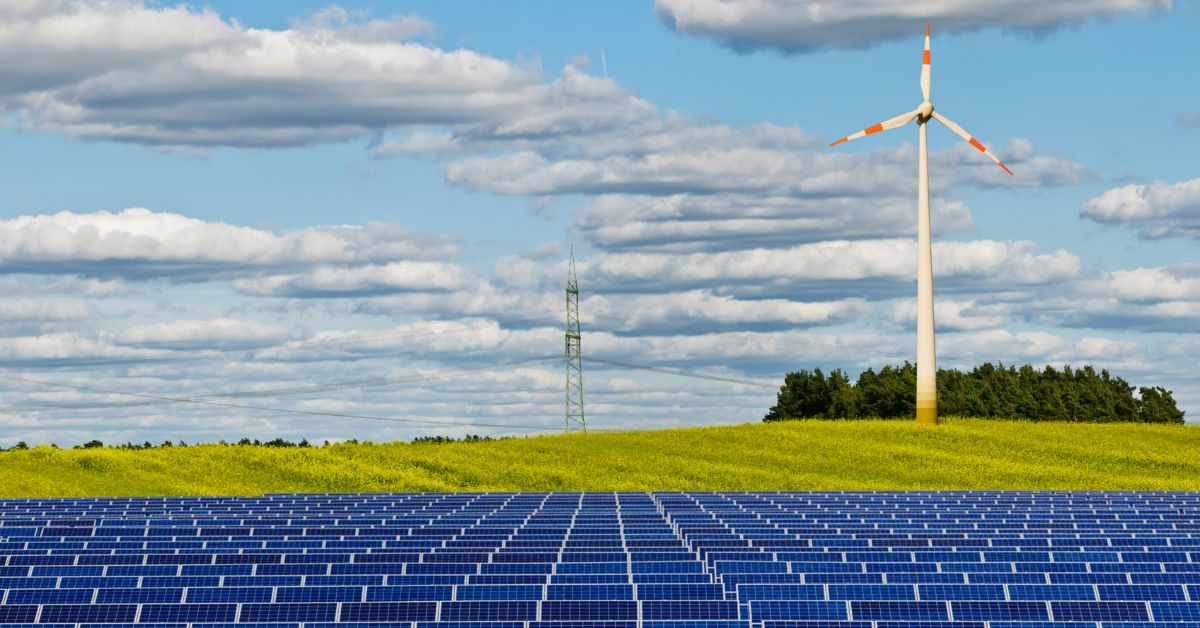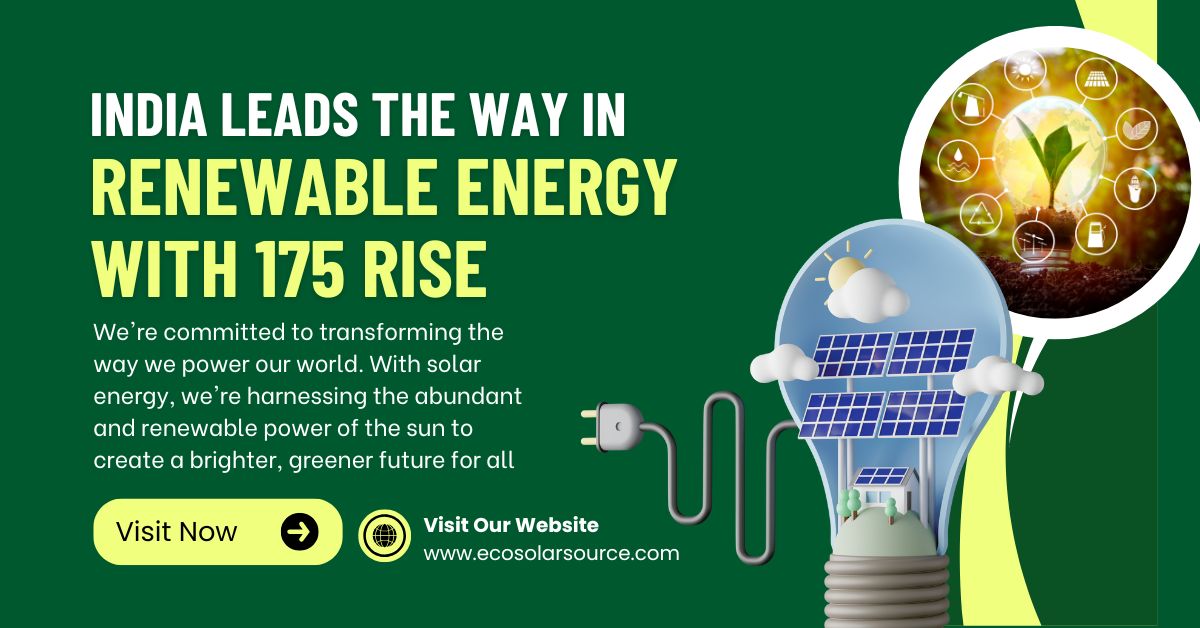India Leads The Way in Renewable Energy With 175 Rise
Know the details about India Leads The Way in Renewable Energy With 175 Rise, India is leading the global renewable energy revolution, targeting a remarkable 175 GW of renewable energy capacity by 2024. This ambitious initiative highlights India’s commitment to combating climate change while addressing its growing energy needs.
With a strong emphasis on solar, wind, and hydropower, India has become a pioneer in harnessing clean energy sources. The country’s renewable energy push is not only reducing its reliance on fossil fuels but also promoting sustainable economic growth. This significant rise showcases India’s leadership in building a greener future, inspiring other nations to follow suit in their sustainability efforts.
Table of Contents
India Leads the Way in Renewable Energy with 175 GW Rise
India, one of the world’s fastest-growing economies, has emerged as a global leader in the transition to renewable energy. The country’s journey toward a sustainable energy future is not just a response to the challenges of climate change but also a strategic move to address its burgeoning energy needs, create economic opportunities, and improve the quality of life for its citizens. With ambitious renewable energy targets, particularly the recent milestone of achieving 175 GW of installed renewable energy capacity, India has taken center stage in the global energy transition.
This post will explore how India reached this significant achievement, the key drivers behind its renewable energy push, the policies and initiatives that have propelled its growth, the challenges faced, and what lies ahead as the nation strives for even higher goals in renewable energy.
The Road to 175 GW: A Transformative Milestone
In 2015, at the Paris Climate Conference (COP21), India set an ambitious target to install 175 GW of renewable energy capacity by 2022. This was seen as an essential step toward mitigating the impacts of climate change while addressing the nation’s growing energy demand. The 175 GW target comprised:

- 100 GW of solar energy
- 60 GW from wind energy
- 10 GW from bioenergy
- 5 GW from small hydropower projects
This ambitious target was a clear demonstration of India’s commitment to transitioning away from fossil fuels and embracing clean energy technologies. As of today, India has successfully crossed the 175 GW threshold, reinforcing its status as one of the world’s leading players in renewable energy. Achieving this milestone has not only transformed India’s energy landscape but also made a significant contribution to global efforts to combat climate change.
Key Drivers Behind India’s Renewable Energy Push
Several factors have driven India’s renewable energy expansion, from economic and environmental imperatives to political and social considerations. Below are some of the critical drivers:
1. Growing Energy Demand
India’s rapidly growing population, industrialization, and urbanization have led to a surge in energy demand. The country’s economy is one of the fastest-growing in the world, and with this growth comes the need for a sustainable and reliable energy supply. Renewable energy, particularly solar and wind, provides an opportunity to meet this demand more cleanly and sustainably.
2. Climate Change Mitigation
As the third-largest emitter of greenhouse gases globally, India faces significant pressure to reduce its carbon footprint. Renewable energy is seen as a critical component of India’s strategy to reduce emissions while promoting sustainable development. The country’s leadership, including Prime Minister Narendra Modi, has been vocal about its commitment to addressing climate change, with renewable energy being a cornerstone of these efforts.
3. Energy Security and Independence
India has historically been heavily reliant on imported fossil fuels to meet its energy needs, particularly coal and oil. This reliance on imports exposes the country to global energy market fluctuations and geopolitical risks. Expanding renewable energy capacity helps India reduce its dependence on foreign energy sources, enhancing energy security and self-sufficiency.
4. Economic Growth and Job Creation
The renewable energy sector presents significant economic opportunities for India. Investments in renewable energy projects create jobs, drive innovation, and stimulate economic growth. According to estimates, the renewable energy sector in India has the potential to generate millions of jobs in manufacturing, installation, operation, and maintenance of renewable energy infrastructure.
5. Technological Advancements and Falling Costs
The rapid advancements in renewable energy technologies, particularly in solar power, have played a significant role in India’s renewable energy growth. The cost of solar panels and wind turbines has decreased dramatically over the past decade, making renewable energy more competitive with conventional fossil fuels. As a result, renewable energy projects have become financially viable and attractive to investors.
Solar Power: Shining Bright in India’s Renewable Revolution
Of the 175 GW renewable energy target, solar power accounts for the largest share, with a target of 100 GW. India’s solar energy capacity has grown exponentially in recent years, driven by favorable policies, falling costs, and significant investments.

1. Solar Parks and Mega Projects
India has been developing some of the world’s largest solar parks and mega-projects. These projects have contributed significantly to the country’s solar capacity. For example:
- Bhadla Solar Park in Rajasthan, one of the largest solar parks in the world, has a capacity of 2.25 GW.
- The Rewa Solar Project in Madhya Pradesh, with a capacity of 750 MW, has set a benchmark for large-scale solar projects in India.
2. Rooftop Solar
In addition to large-scale solar parks, India has also been promoting rooftop solar installations, particularly in urban areas. Rooftop solar offers a decentralized approach to energy generation, allowing households, businesses, and institutions to generate their electricity and reduce their dependence on the grid. The government has set a target of achieving 40 GW of rooftop solar capacity as part of the broader 100 GW solar target.
3. Solar Energy Auctions
India’s innovative approach to solar energy auctions has played a crucial role in bringing down the cost of solar power. The competitive bidding process has attracted both domestic and international investors, leading to record-low tariffs for solar energy. In some cases, the tariffs for solar power have dropped below the cost of coal-fired electricity, making solar a highly attractive option for utilities and businesses.
Wind Energy: Harnessing the Power of Wind
Wind energy is another critical component of India’s renewable energy mix, with a target of 60 GW. India has some of the world’s best wind resources, particularly in states such as Tamil Nadu, Gujarat, and Karnataka. Wind energy has been a cornerstone of India’s renewable energy efforts for over two decades, and the country ranks among the top wind energy producers globally.
1. Onshore Wind Energy
Most of India’s wind energy capacity comes from onshore wind farms. The country’s large land area and favorable wind conditions in certain regions have made onshore wind energy a viable and scalable option. States like Tamil Nadu and Gujarat have been leading the way in wind energy production, with several large wind farms in operation.
2. Offshore Wind Energy
While India’s wind energy capacity is currently dominated by onshore projects, the country has also been exploring the potential of offshore wind energy. Offshore wind farms offer the advantage of higher and more consistent wind speeds, which can lead to greater energy production. The government has identified several locations along India’s coastline with significant offshore wind potential, and efforts are underway to develop the necessary infrastructure and regulatory framework for offshore wind projects.
Biomass and Small Hydropower: Complementing the Mix
In addition to solar and wind, biomass and small hydropower play important roles in India’s renewable energy strategy.
1. Biomass Energy
Biomass energy, derived from organic materials such as agricultural waste, forestry residues, and animal waste, has significant potential in India. Biomass energy projects not only provide a renewable source of energy but also offer a way to manage agricultural waste and reduce pollution. India has set a target of 10 GW of biomass energy capacity as part of its renewable energy strategy.
2. Small Hydropower
Small hydropower projects, typically defined as hydropower plants with a capacity of up to 25 MW, are seen as a way to harness the potential of India’s rivers and streams for clean energy generation. Unlike large hydropower projects, which can have significant environmental and social impacts, small hydropower projects are considered more environmentally sustainable and can be deployed in remote areas to provide localized power generation.
Government Policies and Initiatives
India’s remarkable progress in renewable energy has been driven by a range of government policies and initiatives. The Indian government has taken a proactive approach to promoting renewable energy, with several key policies and programs supporting the sector.
1. National Solar Mission
Launched in 2010, the National Solar Mission is one of the key initiatives driving the growth of solar energy in India. The mission aims to make India a global leader in solar energy by promoting the development of solar parks, encouraging the adoption of rooftop solar, and supporting research and development in solar technologies.
2. Renewable Energy Certificates (RECs)
The REC mechanism was introduced to promote renewable energy generation and trading in India. RECs provide a way for renewable energy producers to sell the environmental benefits of their power generation to other entities, such as utilities and businesses, that are required to meet renewable energy obligations.
3. Green Energy Corridors
To integrate renewable energy into the national grid, India has developed the Green Energy Corridors initiative. This project aims to strengthen the transmission infrastructure required to transport electricity generated from renewable sources, such as solar and wind, to consumers across the country.
4. International Solar Alliance (ISA)
India has played a leading role in the establishment of the International Solar Alliance (ISA), a coalition of countries committed to promoting solar energy globally. The ISA aims to mobilize over $1 trillion in investment in solar energy by 2030 and facilitate the sharing of best practices and technologies among member countries.
Challenges and Obstacles
Despite its impressive achievements, India’s renewable energy sector faces several challenges that need to be addressed to ensure continued growth and success.
1. Grid Integration and Storage
One of the major challenges in scaling up renewable energy is the integration of variable and intermittent sources, such as solar and wind, into the national grid. Energy storage solutions, such as batteries, are critical to managing this variability and ensuring a stable and reliable supply of electricity.
2. Land Acquisition and Environmental Concerns
Large-scale renewable energy projects, particularly solar parks and wind farms, require significant land areas. Acquiring land for these projects can be challenging, especially in densely populated regions. Additionally, there are concerns about the environmental impact of certain renewable energy projects, such as the displacement of local communities and the impact on wildlife.
3. Financial and Investment Challenges
While the cost of renewable energy technologies has fallen significantly, financing large-scale renewable energy projects remains a challenge. Ensuring that there is sufficient investment in the sector, particularly in the development of grid infrastructure and storage solutions, will be critical to meeting future renewable energy targets.
4. Policy Implementation and Coordination
India’s renewable energy sector is governed by a complex web of national, state, and local policies and regulations. Ensuring effective coordination between different levels of government and streamlining policy implementation will be important to overcoming regulatory and bureaucratic hurdles.
The Future of Renewable Energy in India
India’s achievement of 175 GW of renewable energy capacity is a remarkable milestone, but it is only the beginning of the country’s renewable energy journey. The Indian government has already set even more ambitious targets for the future, to achieve 450 GW of renewable energy capacity by 2030.

1. Scaling Up Solar and Wind
India will continue to focus on scaling up its solar and wind energy capacity in the coming years. With advancements in technology and further cost reductions, solar and wind energy are expected to play an increasingly dominant role in India’s energy mix.
2. Expanding Energy Storage
To address the challenges of grid integration and variability, India is likely to invest heavily in energy storage solutions. The development of large-scale battery storage systems and other forms of energy storage will be critical to ensuring the stability and reliability of the grid.
3. Embracing New Technologies
India is also exploring new and emerging renewable energy technologies, such as offshore wind, hydrogen, and advanced biofuels. These technologies have the potential to diversify the country’s renewable energy portfolio and further reduce its dependence on fossil fuels.
4. Strengthening International Cooperation
As a leader in the global renewable energy movement, India will continue to play an active role in international efforts to promote clean energy. The country’s leadership in initiatives such as the International Solar Alliance and its collaboration with other nations on renewable energy research and development will be important to driving global progress in the transition to a sustainable energy future.
FAQs About India Leads The Way in Renewable Energy With 175 Rise
Q1. What is India’s target for renewable energy capacity by 2022?
India set a target of achieving 175 GW of renewable energy capacity by 2022, which includes 100 GW from solar, 60 GW from wind, 10 GW from biomass, and 5 GW from small hydropower.
Q2. Has India achieved its 175 GW renewable energy goal?
India has made significant progress, reaching about 175 GW of renewable energy capacity in 2022, including a large share of solar and wind energy. However, challenges in certain areas have affected achieving the exact targets within the timeframe.
Q3. What role does solar energy play in India’s renewable energy strategy?
Solar energy is the cornerstone of India’s renewable energy expansion, contributing 100 GW of the 175 GW target, focusing on both large-scale solar parks and decentralized rooftop installations.
Q4. How is wind energy contributing to India’s renewable rise?
Wind energy contributes 60 GW of the total renewable energy target. India has been harnessing its wind potential, particularly in coastal regions, to meet this ambitious goal.
Q5. What are the key drivers of India’s renewable energy growth?
The key drivers include government policies like the National Solar Mission, international climate commitments, financial incentives, and the country’s need to reduce reliance on coal.
Q6. What are some of the major challenges India faces in its renewable energy expansion?
Key challenges include grid integration issues, land acquisition problems, financing, regulatory hurdles, and delays in infrastructure development for solar and wind power plants.
Q7. How has India’s renewable energy sector impacted employment?
The renewable energy sector has created a significant number of jobs, particularly in manufacturing, installation, and maintenance of solar panels and wind turbines, contributing to economic growth.
Q8. What impact has India’s renewable push had on its carbon emissions?
The shift towards renewable energy has helped reduce India’s carbon footprint by cutting down on coal-fired power generation, aligning with global climate goals.
Q9. How is India financing its renewable energy projects?
India’s renewable energy projects are financed through a combination of government funding, international investments, and public-private partnerships, supported by incentives like tax benefits and subsidies.
Q10. What are India’s future renewable energy targets beyond 175 GW?
India aims to further expand its renewable capacity to 500 GW by 2030, contributing significantly to global efforts to combat climate change and ensure energy security.
India’s rise as a global leader in renewable energy is a testament to the country’s vision, ambition, and determination to build a sustainable future. The achievement of 175 GW of renewable energy capacity marks a significant milestone, but it is only the first step in a long journey. With the right policies, investments, and technological advancements, India is well on its way to achieving even greater heights in renewable energy, contributing not only to its development but also to the global effort to combat climate change and create a more sustainable world for future generations.
Click here to learn more about India Leads The Way in Renewable Energy With 175 Rise
Click here to learn more about Global Renewable Energy Set to Surge by 2030 IEA Report

